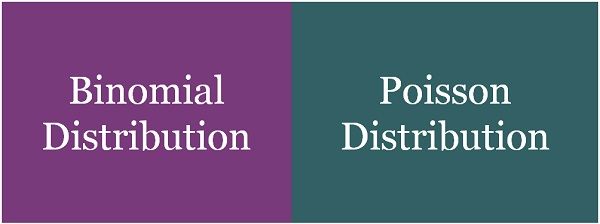 The binomial distribution is one, whose possible number of outcomes are two, i.e. success or failure. On the other hand, there is no limit of possible outcomes in Poisson distribution
The binomial distribution is one, whose possible number of outcomes are two, i.e. success or failure. On the other hand, there is no limit of possible outcomes in Poisson distribution
The theoretical probability distribution is defined as a function which assigns a probability to each possible outcomes of the statistical experiment. The probability distribution can be discrete or continuous, where, in the discrete random variable, the total probability is allocated to different mass points while in the continuous random variable the probability is distributed at various class intervals.
Binomial distribution and Poisson distribution are two discrete probability distribution. Normal distribution, student-distribution, chi-square distribution, and F-distribution are the types of continuous random variable. So, here we go to discuss the difference between Binomial and Poisson distribution. Have a look.
Content: Binomial Distribution Vs Poisson Distribution
Comparison Chart
| Basis for Comparison | Binomial Distribution | Poisson Distribution |
|---|---|---|
| Meaning | Binomial distribution is one in which the probability of repeated number of trials are studied. | Poisson Distribution gives the count of independent events occur randomly with a given period of time. |
| Nature | Biparametric | Uniparametric |
| Number of trials | Fixed | Infinite |
| Success | Constant probability | Infinitesimal chance of success |
| Outcomes | Only two possible outcomes, i.e. success or failure. | Unlimited number of possible outcomes. |
| Mean and Variance | Mean > Variance | Mean = Variance |
| Example | Coin tossing experiment. | Printing mistakes/page of a large book. |
Definition of Binomial Distribution
Binomial Distribution is the widely used probability distribution, derived from Bernoulli Process, (a random experiment named after a renowned mathematician Bernoulli). It is also known as biparametric distribution, as it is featured by two parameters n and p. Here, n is the repeated trials and p is the success probability. If the value of these two parameters is known, then it means that the distribution is fully known. The mean and variance of the binomial distribution are denoted by µ = np and σ2 = npq.
P (X = x) = nCx px qn-x, x = 0,1,2,3…n
= 0, otherwise
An attempt to produce a particular outcome, which is not at all certain and impossible, is called a trial. The trials are independent and a fixed positive integer. It is related to two mutually exclusive and exhaustive events; wherein the occurrence is called success and non-occurrence are called failure. p represents the probability of success while q = 1 – p represents the probability of failure, which does not change throughout the process.
Definition of Poisson Distribution
In the late 1830s, a famous French mathematician Simon Denis Poisson introduced this distribution. It describes the probability of the certain number of events happening in a fixed time interval. It is uniparametric distribution as it is featured by only one parameter λ or m. In Poisson distribution mean is denoted by m i.e. µ = m or λ and variance is labelled as σ2 = m or λ. The probability mass function of x is represented by:
 where e = transcendental quantity, whose approximate value is 2.71828
where e = transcendental quantity, whose approximate value is 2.71828
When the number of the event is high but the probability of its occurrence is quite low, poisson distribution is applied. As for example, Number of insurance claims/day on an insurance company.
Key Differences Between Binomial and Poisson Distribution
The differences between binomial and poisson distribution can be drawn clearly on the following grounds:
- The binomial distribution is one in which the probability of repeated number of trials is studied. A probability distribution that gives the count of a number of independent events occur randomly within a given period, is called probability distribution.
- Binomial Distribution is biparametric, i.e. it is featured by two parameters n and p whereas Poisson distribution is uniparametric, i.e. characterised by a single parameter m.
- There are a fixed number of attempts in the binomial distribution. On the other hand, an unlimited number of trials are there in a poisson distribution.
- The success probability is constant in binomial distribution but in poisson distribution, there are an extremely small number of success chances.
- In a binomial distribution, there are only two possible outcomes, i.e. success or failure. Conversely, there are an unlimited number of possible outcomes in the case of poisson distribution.
- In binomial distribution Mean > Variance while in poisson distribution mean = variance.
Conclusion
Apart from the above differences, there are a number of similar aspects between these two distributions i.e. both are the discrete theoretical probability distribution. Further, on the basis of the values of parameters, both can be unimodal or bimodal. Moreover, the binomial distribution can be approximated by the poisson distribution, if the number of attempts (n) tends to infinity and success probability (p) tends to 0 so that m = np.






Srinithi says
Its wortthy
Catherine says
Thank you – this was helpful.
Asad Ashraf Karel says
A VERY GOOD AND HELPFUL CONTENT. IT’S REALLY WORTHY AND COMPREHENSIVE TO STUDY.
Amare says
I’m thankful to you guys for having forwarded us such useful materials which are highly related to my studies.
Thank you
Hasanuzzjaman says
Thank you